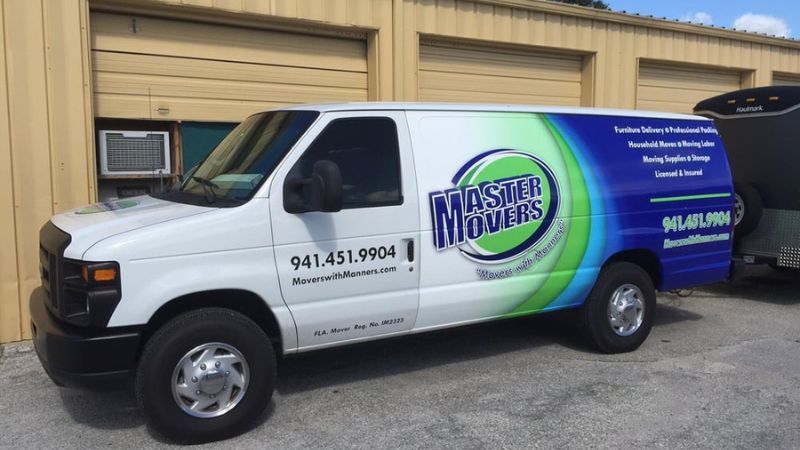Small Business Local Moving Made Easy

Local moving refers to the process of relocating business assets such as office equipment, inventory, and supplies within a short distance, typically within the same city or region. Unlike long-distance moves, local moves are typically completed within the same day, depending on the volume and complexity of items being moved. At Master Movers, we specialize in providing a full-service moving company in Venice, FL, making any local move a hassle-free experience.
For small businesses, local moving can often mean transitioning to a bigger space due to growth, or to a more strategic location for better access to their market and suppliers.
Why Do Small Businesses Move Locally?
Small businesses may choose to move locally for various reasons:
- Expansion Needs: As businesses grow, space requirements can increase, prompting the need for relocation to accommodate more employees, larger inventory, or more sophisticated equipment.
- Market Proximity: Moving closer to target customers or central business districts can provide competitive advantages including reduced delivery times and enhanced customer service.
- Cost Management: Relocating to areas with lower rent or operational costs can significantly reduce overhead and increase profitability.
- Lease Issues: Expiration of leases or changes in property management may necessitate a move to better-suited or more cost-effective locations.
Residential moves are crucial decisions for and require careful planning and execution to ensure they contribute positively to the business's growth and operational efficiency.
Planning Your Local Move: A Strategic Approach
When to Start Planning Your Local Business Move
Timing is a critical element in the moving process and can significantly affect the smoothness and success of your move. Ideally, planning should begin at least three to six months in advance. This allows sufficient time to address logistical details, communicate with stakeholders, and minimize operational disruptions. For small businesses, this planning period is essential to align the moving schedule with business cycles, avoiding peak periods when the impact on business operations would be most severe.
Creating a Moving Checklist
A well-thought-out moving checklist is vital for keeping the entire moving process organized. Beginning your preparations early can significantly reduce the stress associated with moving. Here’s a simple framework for your local move checklist:
- Initial Preparations (3-6 months before move):
- Determine your moving budget.
- Choose a moving date.
- Inform your current landlord and discuss lease termination.
- Start researching potential moving companies.
- Closer to the Move (1-2 months before):
- Finalize your moving company or rental equipment.
- Notify employees, customers, and suppliers about the move.
- Begin packing non-essential items and decluttering.
- Arrange utilities and services at your new location.
- Final Weeks:
- Pack all remaining items.
- Confirm moving day logistics with your movers.
- Prepare an “essentials” box with items you will need immediately post-move.
Budgeting for Your Move
Managing costs effectively is crucial for small businesses undertaking a local move. Consider these budgeting tips:
- Get Multiple Estimates: Obtain quotes from several moving companies to compare prices and services.
- Plan for Extra Costs: Include a contingency fund in your budget for unexpected expenses.
- Save on Supplies: Seek out places where you can get free or low-cost packing materials, such as local stores or online marketplaces.
- DIY Where Possible: Consider which aspects of the move can be handled internally without professional movers, such as packing or minor transport tasks.
A strategic approach to planning and budgeting for a local move not only mitigates financial risk but also ensures that the move progresses as smoothly as possible.
Selecting the Right Moving Service
Types of Moving Services Available for Small Businesses
Choosing the right type of moving service is crucial for a successful and efficient move. Small businesses have a variety of options:
- Full-Service Movers: These services handle everything from packing to transporting to unpacking. Ideal for businesses that prefer a hands-off approach or have delicate equipment.
- Self-Service Movers: This option provides only the transportation of your goods. Packing and loading are done by you or your team, which can be cost-effective but more labor-intensive.
- Specialized Movers: Some companies offer services tailored for specific needs such as moving heavy or sensitive equipment like servers or manufacturing machinery.
Tips for Choosing a Reliable Local Moving Company
Selecting a reliable mover is paramount. Here are some tips to ensure you choose the best service provider:
- Check Licenses and Insurance: Ensure the moving company is licensed and insured. This protects your belongings in case of accidents or damages.
- Read Reviews and Testimonials: Research online reviews and ask for customer testimonials to gauge the reliability and quality of service.
- Experience in the Industry: Look for a moving company with extensive experience, especially with businesses similar to yours.
- Get Detailed Quotes: Request detailed, transparent quotes that break down all potential costs to avoid surprises.
- Ask the Right Questions: Inquire about their handling of emergencies, delays, and their policy on damaged or lost items.
Choosing the right moving service not only ensures the safety of your assets but can also significantly reduce the stress and complications associated with the moving process. Master Movers stands out by your side to offer the best services like residential moving, we’re locally owned and operated, and we’re ready to take the stress and frustration out of your relocation.
Steps and Tips for a Successful Move
Preparing Your Business for the Move
Preparation is the key to minimizing downtime and ensuring a smooth transition when moving. Here are some essential steps:
- Inventory Management: Create a detailed inventory of all items to be moved. This helps in tracking and ensures nothing is lost.
- Labeling System: Implement a color-coded labeling system for boxes and equipment. Labels should indicate the room or person it belongs to, along with contents and handling instructions.
- Handling IT and Technical Equipment: Special care should be taken when moving IT equipment. If possible, use original packaging for computers and servers. Backup all data, and consider hiring IT specialists for the disconnect and reconnect processes.
The Day of the Move
The actual moving day is typically the most stressful part of the moving process. Here’s how to manage it:
- Early Start: Begin the moving process early in the day to maximize daylight hours and give yourself ample time to address unforeseen issues.
- Roles and Responsibilities: Assign specific roles to team members. Having a point person for different areas, such as IT, furniture, and customer communications, can streamline the process.
- Emergency Kit: Prepare a moving day kit with essential tools, paperwork, snacks, and other supplies that might be needed quickly.
Post-Move Considerations
Once the move is complete, a few important tasks remain:
- Setting Up the New Location: Arrange furniture and equipment according to the planned layout as quickly as possible to allow operations to resume.
- IT and Utilities Check: Ensure all utilities are functioning, and IT systems are set up and working.
- Feedback Session: After settling in, hold a feedback session with your team to discuss what went well and what could be improved. This information is invaluable for optimizing future processes.
Effective execution on moving day and thoughtful post-move adjustments are vital to resume business operations with minimal interruptions and stress.
Leveraging Technology and Resources for Moving
Utilizing Technology to Simplify the Moving Process
In today’s digital age, technology can significantly ease the stress and complexity of moving. Here are some technological tools that can help:
- Inventory Apps: Use mobile apps designed for inventory management to keep track of items throughout the move. Apps like Sortly or Magic Home Inventory allow you to categorize items, add photos, and even set location boxes.
- Project Management Tools: Tools like Asana, Trello, or Monday.com can help plan the move, assign tasks, and track progress. They're crucial for maintaining timelines and ensuring everyone is on the same page.
- Communication Apps: Apps like Slack or Microsoft Teams can facilitate instant communication between team members on moving day and during the setup phase in the new location.
Resources for Additional Support
Besides technology, various other resources can aid in a seamless move:
- Local Business Associations: Many cities have local chambers of commerce or business associations that offer resources and advice for small businesses planning a move.
- Online Checklists and Templates: Utilize online resources that provide free checklists and planning templates specifically designed for business relocations.
- Professional Consultants: For complex moves, considering hiring a consultant specializing in business relocations to navigate the intricacies effectively.
Leveraging the right mixture of technology and external resources can not only streamline the moving process but also reduce the burden on your employees, allowing them to focus on their core tasks.
Ensuring Continuous Business Operations During the Move
Strategies to Minimize Downtime
Maintaining operational continuity is critical during a local move to minimize financial impact and maintain customer trust. Here are strategies to achieve minimal downtime:
- Detailed Planning: Use your project management tools to create a step-by-step plan for every phase of the move, which includes a timeline for when specific sections of your business will be packed, moved, and set up.
- Backup Operations: Set up temporary solutions such as remote work setups or staggered moving phases so that not all operations are disrupted at once.
- Phased Moving: If possible, move in stages to ensure that at least part of your operation is functional at all times. This might involve setting up critical parts of your business at the new location before moving less critical sections.
Effective Communication During the Move
Communication is key to managing expectations and maintaining relationships during the moving process:
- Internal Communication: Regularly update your team about move progress and any expected disruptions. Utilize daily briefings or dedicated chat channels.
- Customer Communication: Inform customers well in advance about how the move might impact them. Provide clear information on how operations will be maintained and any changes in service they might expect.
- Stakeholder Updates: Keep suppliers, vendors, and other key stakeholders in the loop. This can be through weekly email updates or a temporary webpage dedicated to move-related news.
By thoughtfully planning and communicating, small businesses can significantly reduce the risks associated with operational disruptions during a move.
Common Mistakes to Avoid During a Local Move
Equally important are the lessons learned from less successful moves:
- Underestimating the Time Required: Many small businesses fail to allocate enough time for packing and setup, leading to rushed moves and operational downtime.
- Poor Communication: Not keeping employees and customers informed can lead to confusion and damage relationships.
- Lack of Professional Help: Attempting to handle all aspects of the move internally, especially IT and logistics, without professional assistance can lead to complications and increased costs in the long term.
Each of these case studies and anecdotes offers vital learning points, emphasizing the importance of thorough planning, adequate resource allocation, and clear communication.
Your Local Small Business Move
When it comes to moving your small business locally in Venice, FL, partnering with a trusted and experienced moving company like Master Movers is key. We specialize in local moves and are dedicated to making your business relocation as seamless as possible. With our comprehensive moving services and expert team, you can focus on what you do best running your business while we handle the logistics of your move.
Our Latest Blog





